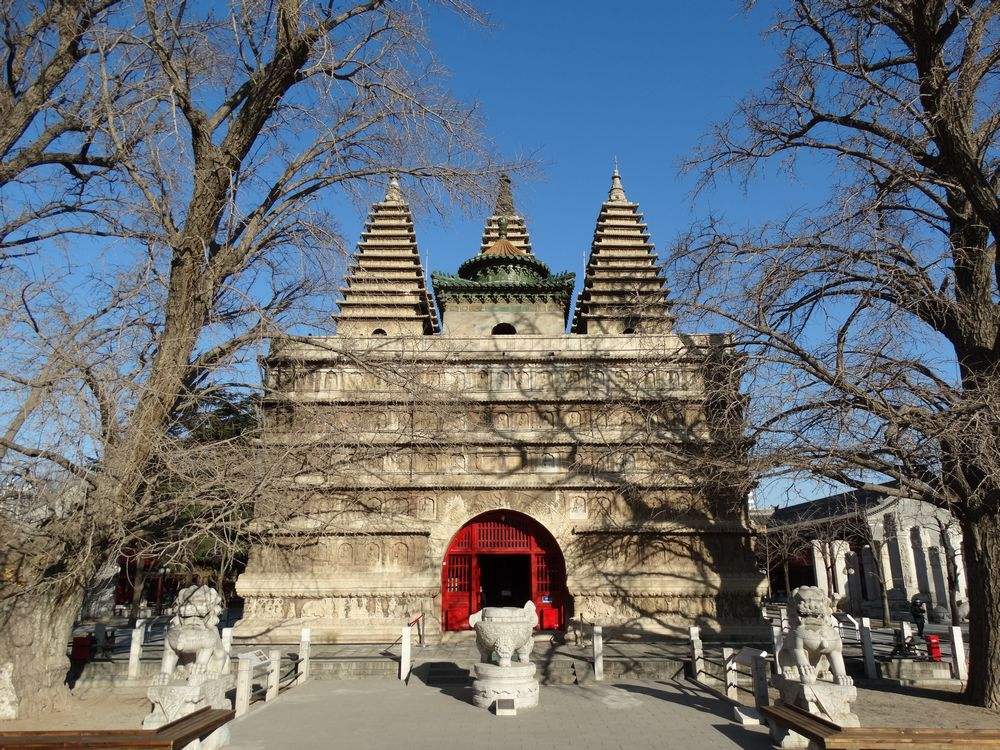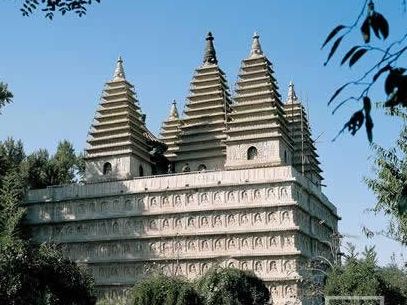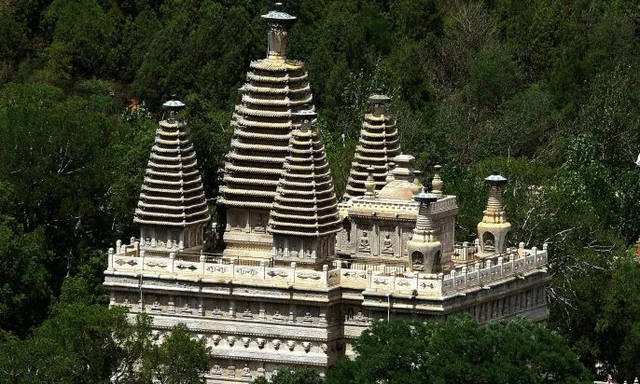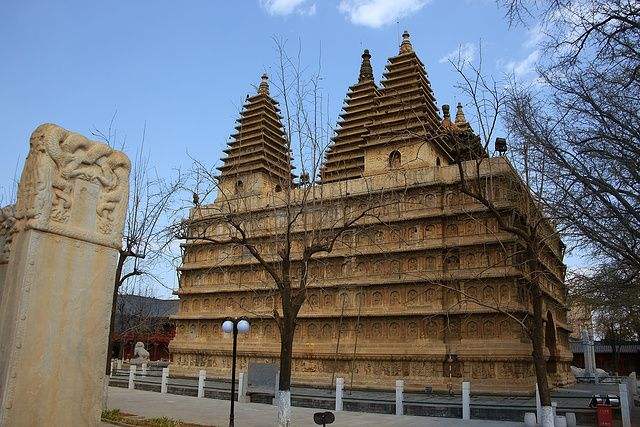Diamond Throne Pagoda in Zhen jue Temple
6 min readDiamond Throne Pagoda in Zhenjue Temple is the earliest and most delicate Diamond Throne Pagoda extant in China. It is commonly known as Five-Pagoda Temple Pagoda.
Different from other Diamond Throne Pagodas, this one in Zhenjue Temple not only follows the basic modeling of Indian stupas, but also makes a little modification i accordance with Chinese traditional architectural features. Although this DiamondThrone Pagoda is small in size, its base is obviously heightened. The five pagodas on the base are almost of the same height, instead that the main pagoda in the middle stands higher than the other four. This arrangement makes the five pagodas more balanced in proportion.A1l the pagodas are of multieave like, but varied instyles and different from each other. There is a pavilion at the entrance of the base used to keep out winds and shelter people from rains, which combines naturally with the five pagodas. Instead of destroying the pagoda’s architectural style, this pavilion adds to the charm of the pagoda and embodies a strong Chinese feature.

The base of this Diamond Throne Pagoda is square. At the bottom of the base are dial feet, above which is a big throne of Mt. Sumeru. At the waist of the throne of Mt. Sumeru patterns of a lion, an elephant,a horse,a peacock and a greenfinch arecarved. On the planes of both the upper column and the lower column on the waist part, there is relief of a New Year congratulation speech from Pagas-pa to KublaiKhan both in Sanskrit and Tibetan. The speech is written beginning from the right side of the main gate on the south side of the throne, across the whole pagoda and finishing at the left side of the main gate. The base of the throne of Mt. Sumeru has a unique feature. Each side is divided into five layers of niches by short eaves. Each layer is divided into many small niches, in which a statue of sitting Buddha is carved. These statues are peaceful in expressions and different in hands’ gestures. There are all together 384 statues. Adapting Chinese traditional carving skil1, the lines of the statues are delicate and smooth, the images are vivid and lovely and the whole statues are due stereoscopic.

The arrangement of the carving adapts the traditional symmetric method so that the themes become more outstanding, leaving such an impression that these carvings are classical, elegant and tasteful. There is an arched door separately on the northand south sides of the Diamond Throne. There inlays a white marble tablet above thearched door on the south side, saying “Diamond Throne made under imperial order”. On the arched doors relief patterns of birds and beasts are carved as decorations.
Inside the arched door is a square room with a square central pillar in the center.
There is a niche on each side of the four sides around the central pillar, with a statue of Buddha in it. The southern side is a statue of Sakyamuni; the east side is a statue of Medicine Buddha, lord of the eastern paradise of pure Lapiz Lazuli, thewest side is a statue of Amitaba Buddha, lord of the western paradise of pure landand the north side is a statue of the Buddha of fixed light, who is said to be the teacher of Sakyamuni. On both the east and west sides in the room, there is separately a path to the top. Similar to other Diamond Throne Pagodas, there is a pavilion at the entrance of the pagoda. Built with a round ceiling and square eaves, this pavilion is covered with yellow and dark green colored glaze. In addition, there is a curling dragon caisson ceiling inside the top of the pavilion, indicating to visitors that this used to be an imperial temple in the past.
There are all together five multieaved stone pagodas on the base. They are square ones in brick and stone structure, covered at the surface with stripes of stones in the color of pale and white. The one in the middle is 8 meters high and consists of 13 stories. The rest four are 7 meters high and consists of 1l stories.

There is one throne of Mt. Sumeru under each pagoda. Patterns of animals, such as lions, elephants and horses are carved on the waist part of these thrones. Besides, each side of the throne of Mt. Sumeru is separated into three parts by diamond clubs. There are three lucky steles in the center of the middle part, on the both sides of which is a lying lion, with its front arms raising highly as if it was praying for the longevity of the emperor. In the other two parts at the side lies a tamed and lovely elephant.
The most attracting thing is that there raised a carving of a pair of Buddha’s feet at the south side center of the main pagoda’s throne of Mt. Sumeru. The feet are raised with the underside of the arch facing outward. There is a lotus under the feet and patterns of Eight Treasures in Buddhism and curly grasses around them.
There are two explanations why Buddha’s feet are carved. One says that Buddha hadstood on a big stone and left to the world plenty of teachings before he died of disease. Therefore, his followers carved a pair of feet on the stone he had stood on as a commemoration. Another says that after Sakyamuni’s death, the fire was not lightened during the cremation because his disciple Kashyapa did not come. After Kashyapa arrived, the feet of Sakyamuni showed out from the wooden coffin and thefire was lightened. To memorize this event Sakyamuni’s follower carved on pagodas the Buddha’s feet. This is the only raised pair of Buddha’s feet existing in all pagodas in Beijing. Others are all dented.
Lotus petals are carved in a circle between the throne of Mt. Sumeru and the first floor of the pagoda as decoration. Similar to other Diamond Throne Pagodas, niches are set up at the four sides of the body part. The body is covered with multieaves. Above the multieaves is a pinnacle.A1l the pinnacles of the five pagodas are small upturned alms bowl-like ones. The one on the middle pagoda is made of bronze while the rest four are made of stones. They are intricate in appearance, beautiful and elegant.
According to historical records, after this pagoda was built in the Ming dynasty, the carvings on the surface were protected by blood materials. The so-called blood materials were actually mixtures of pig blood, lacquer putty and paste.

They were mixed with polished glutinous rice water, stirred even and painted on the body of the pagoda. One layer of sackcloth was covered on it afterwards. The craftsmen coated on the sackcloth with two coatings of lacquer. After the paint went dried, they covered on it another layer of sackcloth, then two coatings of lacquer on the sackcloth again. They repeated these procedures again and again until it reached a certain thickness. Today, we can still see the dark red marks in the niches and in the dents of the carvings. The surface of the pagoda takes on a light orange color. In the Qing dynasty, Emperor Qianlong issued an order to renovate the Zhenjue Temple and Diamond Throne Pagoda. In order to avoid the taboo on the personal name of his farther Emperor Yongzheng, Yinzhen, Emperor Qianlong changed the name of Zhenjue Temple into Zheng jue Temple.








